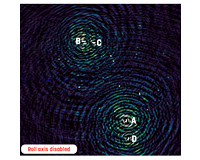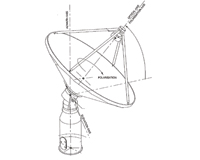BETA demonstrates clear benefits of ASKAP antennas' third axis
|
A BETA observation performed with the roll axis |
|
Click on the image above for more detail. |
September 2014
The ASKAP Commissioning and Early Science team has been busy working with BETA – the Boolardy Engineering Test Array (BETA) – to demonstrate key features of the telescope design and improve understanding of the methods required to maximise science output with ASKAP.
These features play a significant role in the quality of early science results already achieved with BETA.
BETA represents the first six ASKAP antennas installed with Mk I PAFs at the Murchison Radio-astronomy Observatory, and is already a functioning radio telescope being used to prepare the team for the fit-out of the full ASKAP telescope.
Like conventional radio telescopes, ASKAP antennas move on azimuth and elevation axes. However, the design of the ASKAP antennas also includes a third ‘roll axis’, which allows the primary reflector and receiver to be rotated about its optical axis, ensuring the multiple beams formed by the ASKAP PAFs remain fixed with respect to the sky as an observation progresses.
This is the first time, anywhere in the world, that dishes moving around three axes have been used for radio astronomy.
The roll axis allows ASKAP to observe in directions different to where the antennas are pointing, and beam stability that offers significant improvements such as image quality and accuracy of polarisation.
To demonstrate this, observations of a standard test field containing numerous bright sources were made with, and then without, the roll axis engaged. Both observations were of the same length and subjected to an identical calibration and imaging pipeline.
The results show that with the roll axis disabled, the corresponding observation demonstrates significant errors, whereas using the roll axis leads to a significant improvement in the achievable dynamic range of the images.
The use of the roll axis also offers further savings on computer resources by reducing the amount of data processing required to calibrate the data. The rotation of the primary beam of a radio telescope with respect to the sky is a long standing problem in radio astronomy, particularly for the deepest observations or those requiring polarimetry, and is generally (expensively) addressed in the software domain.
Incorporating the roll axis into ASKAP antenna hardware removes this software issue entirely, resulting in significant reductions in the demands placed on the real time data processing system.
These results, along with the recent on-ground aperture array results, will enable the team to generate an assessment of system performance, and also fully characterise the operation of the Mk II PAF system.
To find out more about the ASKAP antennas' three axis movement, see ASKAP spins it right round, baby, on the Universe@csiro blog.
Back to Latest ASKAP News page.


